When I first entered the cryptocurrency space at the end of 2014, I was a fresh graduate with 200,000 yuan in startup funds from my parents. Now, after 10 years in this field, having experienced three liquidation events, I once lost so much that I couldn't pay my rent. I had also managed to grow 500,000 yuan into 80 million during the 2021 bull market through precise planning.

Looking back now, the cryptocurrency market has never been a casino, but a crucible that tests human nature. Today, I share the practical insights I have gained over these 3000 days. Understanding just one can help you avoid liquidation traps, and three insights are enough to stand firm in this market.
1. My Four-Stage Growth Trajectory
2016-2017: Crazy Period
I profited from the first wave by investing in altcoin private placements, making a fortune as Litecoin surged from 30 to 2000, and NEO increased by 500 times. At that time, I thought I was destined for greatness, using 10x leverage to chase after speculative coins. However, when regulations came in '94, I lost all my profits in three days and owed the platform 300,000.
2018-2019: Dormant Period
After three months of hard work to pay off debts, I began to focus on studying candlestick patterns. I printed out the historical trends of all mainstream coins and covered the walls, discovering that 90% of explosive rises have traceable patterns. The biggest takeaway from this phase: The market is never short of opportunities; what is lacking is the patience to wait for them.
2020-2021: Explosive Period
Seizing the DeFi wave, from UNI to AAVE, I strictly followed the criteria of "market cap below 500 million + active community + code audited" to filter projects, and within half a year my assets multiplied by 160 times. At this point, I understood that true high returns come from precise control of trends.
From 2022 to present: Steady Period
Convert 80% of your position into BTC and ETH, leaving 20% for swing trading. After experiencing three bull and bear markets, I finally understood that the survival rule in the cryptocurrency space is not to get rich quickly but to survive through each cycle.
So how do we excel in cryptocurrency trading? Once a person enters the financial market, it is hard to turn back. If you are currently at a loss and still feel confused, but plan to make cryptocurrency trading your second profession, you must understand the "BIAS indicator trading strategy". Understanding it deeply can help you avoid many detours. These are personal experiences and feelings, I suggest saving them and reflecting on them repeatedly!
In 8 minutes, understand the (deviation rate): Learn to use the BIAS indicator, and you'll be a step ahead in short-term rebounds!
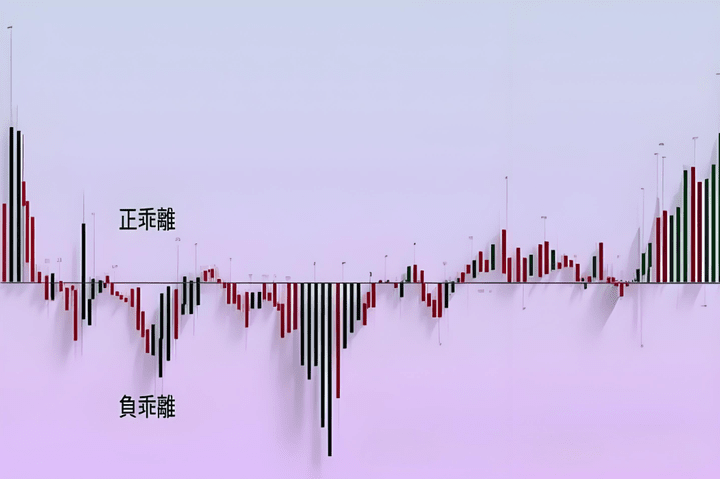
I believe many traders have not heard of the deviation rate, nor have they applied it to their technical charts. However, as a type of auxiliary technical analysis, the application value of the deviation rate is often underestimated.
If you often waver in trading and need an auxiliary tool to help you confirm your observations, the deviation rate can be a good attempt.
Next, I will take you traders into the world of deviation rates to explore and learn about all related knowledge points, and apply the deviation rate to your charts.
What is the deviation rate?
Deviation Rate Analysis (BIAS Ratio / Deviation Rate) is also known as Deviation Rate Analysis or the BIAS indicator. It is an auxiliary technical indicator primarily used to measure market volatility and identify the gap and deviation between market prices and average prices. The higher the deviation rate, the greater the likelihood of a market correction.
In addition, the BIAS indicator can effectively help traders increase their success rate in buying and selling and is often used to avoid situations of buying high and selling low.
Deviation Rate Calculation Logic
The fundamental logic of the deviation rate is based on the premise that, in the absence of specific influencing factors, normal fluctuations in stocks or markets will always return to the average value within a certain time period.
Generally, the BIAS indicator is based on the average line/moving average, compared with the current market price to obtain the price difference, then dividing the obtained difference by the current average value, multiplying by 100 to finally derive the percentage difference between the current price and the average price.
The further the percentage deviates from 0, the greater the chance that the exchange rate or stock will correct back to the average value.
The deviation rate calculation formula is as follows:
Deviation Rate = [(Current Price - Average Price) / Average Price] x 100
The average price seen in the formula is actually the average line. Usually, the average line's setting depends on the market and individual stock habits, so the obtained deviation rates may differ.
Next, let us apply the deviation rate to the charts and conduct analysis.
How to read the deviation rate
The histogram displayed below Figure 1 shows the BIAS indicator. The system's default setting is to calculate the ratio of the current closing price to the average closing price of the previous 24 candlesticks (24-period moving average deviation rate) and present it in percentage form.
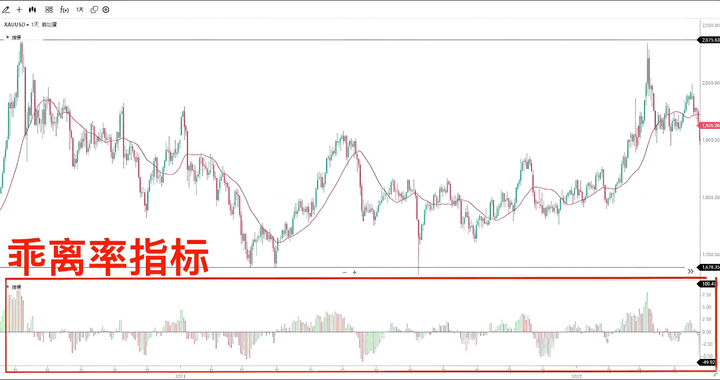
Figure 1
In the BIAS indicator, the cyan histogram represents rising candlesticks, while the brown histogram represents falling candlesticks.
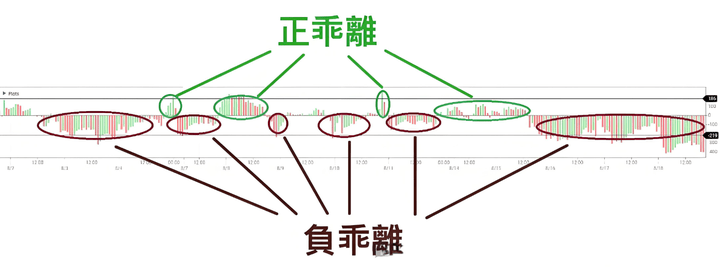

After learning how to read the deviation rate, we will enter the principles of buying and selling based on the deviation rate.
How to find buying and selling points through the deviation rate
Setting the deviation rate is actually relatively simple; it mainly involves trading in abnormal market conditions. An abnormal market refers to a significant deviation between the market price and the average price. When the deviation is too large and far from the zero line (0%), the market can be deemed overbought or oversold.
When the deviation rate exceeds a certain threshold, indicating an abnormal overbought or oversold condition, it is the best time to determine buying or selling points. For example:
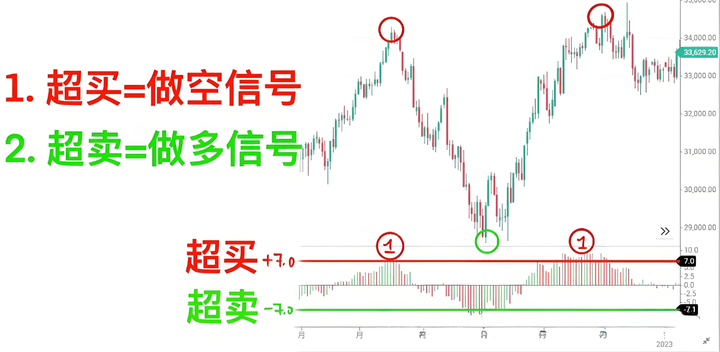
When the deviation rate exceeds a certain positive threshold (e.g., +7.00%), it can be regarded as excessively bought (overbought) and may be seen as a signal to sell or short.
When the deviation rate exceeds a certain negative threshold (e.g., -7.00%), it is considered excessively sold (oversold) and can serve as a signal for buying or going long.
How to use the deviation rate for practical operations
Figure 2 is the daily chart of Gold/US Dollar (XAU/USD). From Figure 2, we can observe that under normal circumstances, negative deviations are maintained within -3.50%. Thus, anything exceeding -3.50% can be considered as over-deviation/oversold (i.e., the market price deviates from the 24-period moving average by more than -3.50%).
Similarly, positive deviations generally stay within +4.00%. Therefore, when the deviation rate exceeds +4.00%, it can be seen as over-deviation/overbought (i.e., the market price deviates from the 24-period moving average by more than +4.00%).
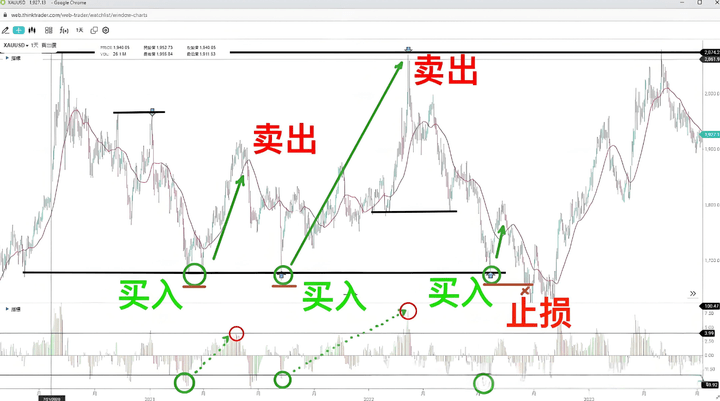
Figure 2
In the figure, three trading examples are listed. The trading strategies are as follows:
1. Buy/Go Long
When the market price falls below the -3.50% cyan marked area, indicating oversold characteristics, one should buy/go long.
2. Stop Loss
To control risk, set a stop loss just below the market price (at the red line).
3. Take Profit
Take profit can be divided into two batches:
One part can realize profit-taking when the deviation rate returns to 0%.
The other part can take profit when the positive deviation rate reaches +4.00% (overbought).
Example 2's entry and exit methods are roughly similar to Example 1, but it shows that market prices may need more time to achieve our expected results (oversold take profit). Compared to Example 1, Example 2 can earn relatively more.
Example 3 also follows the same entry method as the previous two examples; however, unlike the expected (oversold) in the previous two examples, Example 3 did not show the anticipated condition and instead fell below our stop-loss point after the market price returned to the average.
As a disciplined trader, we should stop losses during such times and conduct a review of our trading strategy to identify areas for improvement.
In the above, we have understood the buying and going long operations of the deviation rate; traders can similarly infer the opposite method to sell or short the products they want.
Precautions for Using the Deviation Rate
When applying the BIAS indicator to the charts, we must understand that the application methods and parameters of the BIAS indicator may vary in different markets. Traders can adjust the settings under the BIAS indicator in the chart to meet the specific product's needs for a better-matched deviation rate.
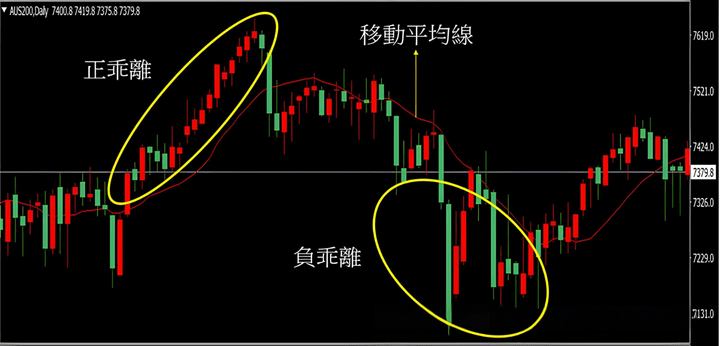
Different time period charts of the same product will display different deviation rates, so the required parameters may vary accordingly. This is because the deviation rate is calculated based on market data over a certain time period, and different periods will reflect varying market volatility and trends.
Therefore, traders need to consider the time period being analyzed when choosing appropriate parameters to ensure that the deviation rate indicator effectively reflects the actual market situation.
When using the BIAS indicator, traders must also closely monitor news events and market data. This will help you determine whether market anomalies have a reasonable basis or whether they are an overreaction.
Since the BIAS indicator is a leading indicator, traders need to be cautious not to trade against the market trend, as this greatly reduces your risk while trading and increases your returns.
If you are also a tech enthusiast, you should understand the following figure:

Finally, I would like to share a set of iron rules for trading cryptocurrencies that I have summarized over the years:
General Patterns in the Cryptocurrency Market
In the past, the cryptocurrency market was a confrontation between the East and the West, with trends occurring both day and night. Most trends happen during Western hours, between 21:30 and 7:30 Beijing time. Major rises typically occur in the early morning, so a qualified trader should go to bed at 20:00 and wake up at 4:00 to monitor trading.
1. During significant daytime declines in the domestic market, one must buy the dip; at 21:30, foreigners will push the market up.
2. If there is a significant rise during the day, do not chase the high; it will likely fall back in the evening.
3. The key signal for entering and exiting is the spike; the deeper the spike, the stronger the buy and sell signal.
4. Major meetings or positive news will lead to a rise, but will fall once it materializes.
5. Group discussion schemes, community recommendations to buy coins, and the talks sound enticing; you get excited and end up getting trapped, leading to counterproductive actions. Which coin is hot, extremely hot? You can short it immediately.
6. Recommendations from group friends may seem uninteresting to you, but there is a high probability of a breakout. When in doubt, it might be worth trying a little.
7. When you are heavily invested, liquidation is inevitable; why? You are on the exchange's liquidation watchlist.
8. After your short position's stop loss is completed, it will definitely drop. If it doesn't trick you into exiting or explode, how will it drop? For example, TRB.
9. When you are about to break even, just a bit more, and the rebound suddenly stops, how can you exit and run?
10. When you take profit, the market goes up; if you don't exit, how can the market rise? The car is too heavy.
11. When you're excited, the market crashes as expected; your excitement is also a bait from the market makers.
12. When you are broke and every project is rising, making you FOMO, you rush to enter the market. So you understand that the market is manipulated with over 80% probability; you must control your position and be proactive. Clearly, do not enter the market until the market makers have completed their operations. The moment you enter, the exchange is the butcher, and you are the meat. Trading is a test of patience, composure, and timing. Let's encourage each other.
"Calm waters can hide great storms" reminds us to stay vigilant and not be deceived by surface tranquility, to keenly sense the potential risks in the cryptocurrency market. Entering the market involves risks, operations require caution; do not envy others making profits, and do not blindly follow others' leads. Your money must be your own responsibility. Investing is like planting trees; it takes time and cannot be rushed. If done well, the fruits will be abundant; if done poorly, you might end up with nothing.
No matter how diligent the fisherman, they won't venture out to fish in a storm; rather, they protect their boat diligently. This season will eventually pass, and the sunny day will come! Follow me for both fish and fishing skills; the door to the cryptocurrency market is always open. Only by going with the trend can you have a life that flows with it. Save this and keep it in mind!



